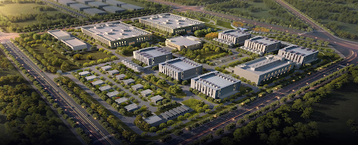Data centers have never been more crucial, driven by unrelenting digitalization, rising digital adoption, and buoyed by an ongoing pandemic that is driving an unprecedented surge in digital commerce and digital communications.
Advanced technologies such as superfast 5G, artificial intelligence (AI), and continuing investments in the cloud will only boost demand further.
Indeed, the number of racks in the global data center market is projected to reach 19.6 million this year and surpass 24.9 billion by 2025, an annual increase of over a million new racks.
Growing colocation market opportunities
The sharp growth of the data center market points to a lucrative growth opportunity and the chance for existing players to capture a larger slice of the market share.
Of course, achieving profitability depends on various factors such as business models, the location of data centers, and operating costs.
To ensure profitability, overheads must be kept low with an Operations and Maintenance (O&M) design that keeps operational costs down, as well as a lower Power Usage Effectiveness (PUE) for a green data center and to reduce energy costs.
Prefabricated, modular components
Prefabricated, modular components reduce construction time by 50 percent. And though a fast time-to-market can bring the provider to profit earlier, there is another compelling reason to shorten the construction cycle.
As customer expectations grow, colocation providers with lengthy construction times are at risk of falling out of contention.
The ability to rapidly deploy a data center is effectively addressed by Huawei’s FusionDC solution, which offers a complete suite of prefabricated and modularized components to build a new data center from zero.
With this innovative approach, colocation providers can deploy more cabinets within the same area, lower their operational costs, and achieve a time to market as short as six months.
A fully modular approach maximizes the value of the data center by increasing the Internal Rate of Return (IRR) by as much as 50 percent, shortening the lead time to Return On Investment (ROI) by one year.
This is possible because key deployment phases such as the prefabrication of components and pre-installation of racks can be done in parallel with civil construction works.
Pre-testing makes it possible to skip time-consuming trial runs and recertification processes for even faster deployment.
High-density power supply systems
High-density power supply systems release more room for revenue-generating IT cabinets.
Within the Smart DC, the power supply and distribution system should be complemented with a high-density, ultra-efficient Uninterruptible Power Supply (UPS) with 100 kW/3U module and an online efficiency of up to 99 percent.
By using SmartLi lithium battery cells with a lifespan of ten years – at least twice that of lead-acid alternatives – and high energy density, the physical footprint of power systems can be reduced to install more IT cabinets.
Efficient cooling
Efficient cooling reduces PUE by up to 10 percent for additional power savings, with proper use of free cooling greatly reducing the power consumption of the data center.
The Huawei FusionCol indirect evaporative cooling system has a built-in heat transfer core to efficiently utilize external cooling sources.
Indirect heat exchange effectively avoids external air quality interference. The integrated modular design greatly reduces the footprint and reduces the deployment difficulty and period.
The secret to Huawei Cloud’s rapid deployment in China
Huawei Cloud is planning to deploy five regional centers and over 30 city nodes across China.
Indeed, through high-speed network interconnection, Huawei will build high-speed cloud backbone networks around the world, covering more than 180 countries in eight regions, to implement cloud-network synergy and serve enterprise globalization.
Based on the twin concepts of prefabrication and modularization, Huawei Cloud data centers take advantage of Huawei's modular data center solutions, which include all cabinet, power supply, and distribution systems – including Huawei PowerPod and Huawei SmartLi – as well as cooling systems, which use indirect evaporative cooling, and smart management systems.
With fully modular, fully prefabricated architecture, delivery times tumble to just six to nine months, while flexible architecture also supports the evolution of IT devices.
Indirect evaporative cooling and iCooling Artificial Intelligence (AI) technologies also help to save energy, improving Power Usage Effectiveness (PUE) by eight to 15 percent.
Requiring less physical space to deploy, PowerPod is a converged power supply that promotes energy savings, with predictive, AI-powered O&M ensuring zero service interruptions.
AI also promotes automatic driving for data centers, while digital O&M reduces related costs by 35 percent. Intelligent asset management further improves resource utilization, by 20 percent.
With a simplified construction mode, an efficient power supply and distribution system, an energy-saving cooling solution, and smart infrastructure O&M management platform, Huawei Cloud is committed to building low-carbon and intelligent data centers.
Huawei smart data centers are reshaping the data center industry, offering flexible service deployment, reduced electricity bills, and significantly lower initial investments, to maximize the value of the data center to help customers achieve business success.


